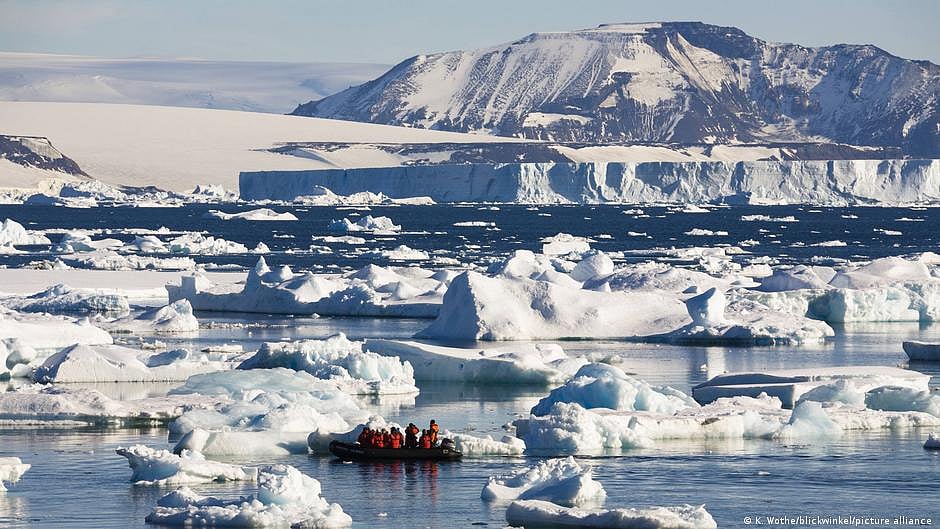Environment
Antarctica’s rare warming may trigger unusual weather in Australia
In the Antarctic winter, this upper atmosphere normally stays near –55°C, held by strong polar winds and the absence of sunlight

A rare and striking atmospheric phenomenon is unfolding high above the icy expanse of Antarctica, where temperatures in the stratosphere have soared a staggering 35°C above the seasonal average, the Down to Earth reported.
This sudden stratospheric warming — a dramatic rise in temperatures 12 to 40 kilometers above the ground — has sent ripples of curiosity and concern across the scientific community, hinting at possible consequences for weather patterns far beyond the frozen continent.
Normally, during the depths of the Antarctic winter, this upper layer of the atmosphere hovers at a bone-chilling –55°C, kept in check by the fierce polar winds and the long absence of sunlight. Yet this year, readings have spiked to around –20°C, as powerful atmospheric waves carrying heat from the surface ascend into the stratosphere. Three distinct pulses of heat have driven these extraordinary surges, each pushing temperatures up by 25°C or more.
While sudden stratospheric warming events are common in the Northern Hemisphere, occurring roughly every two years, they are far rarer in the south. Historical records suggest that events of this magnitude in Antarctica occur perhaps once every six decades. However, recent research reveals that, if we include somewhat milder events such as those in 2019 and 2024, these phenomena may be more frequent than once believed.
Published: undefined
The science behind the warming
High above the polar ice, the stratospheric polar vortex — a massive, rotating column of frigid air — typically traps the cold air above Antarctica, isolating it from warmer currents at lower latitudes. Yet atmospheric waves, much like the undulating swells of the ocean, occasionally disrupt this vortex. During the current Antarctic winter, such waves have ascended from the surface into the stratosphere, bringing pulses of heat that interact with the polar winds to generate sudden warming.
Though described as “sudden”, the process unfolds over days or weeks, often catching meteorologists by surprise. Its effects, however, are profound and can extend thousands of kilometers, influencing weather patterns far from the polar regions.
Implications for Australia
When the stratosphere above Antarctica warms unexpectedly, southeastern Australia often experiences drier and warmer conditions during the ensuing spring and summer. Historical precedents, such as the 2019 warming, contributed to the extreme heat and bushfire conditions during the Black Summer of 2019–2020.
Yet, the relationship is not straightforward. This year, forecasters are predicting a warmer-than-average spring, accompanied by increased rainfall in eastern Australia. The interplay of warm ocean currents, which promote evaporation and rainfall, may counterbalance the usual drying influence of the Antarctic warming. This illustrates the complexity of Earth’s atmospheric systems, where multiple factors converge to shape the weather we ultimately experience.
Published: undefined
Wider impacts
Beyond surface weather, sudden stratospheric warming can affect the ozone layer. A warmer polar stratosphere tends to reduce ozone depletion, allowing more of the protective gas to migrate toward the poles. This shields life on Earth from harmful ultraviolet radiation while simultaneously altering atmospheric dynamics in subtle ways.
Rarity and research
While sensationalised as rare, these warming events are not unprecedented. Northern Hemisphere occurrences are well-documented, whereas Southern Hemisphere events, though less frequent due to Antarctica’s intense stratospheric winds, are now being studied more closely. Scientists are developing better methods to detect and predict these events, shedding light on their frequency and potential implications.
A complex forecast
Ultimately, sudden stratospheric warming is one thread in the intricate tapestry of global weather. Its presence in Antarctica this year may influence Australia’s spring and summer, but the ultimate outcome depends on a confluence of factors, including ocean temperatures and other atmospheric dynamics. For now, meteorologists and climatologists alike watch the Southern skies with keen interest, recognising that the frosty heights above Antarctica can ripple across the globe in ways both subtle and dramatic.
Published: undefined
Follow us on: Facebook, Twitter, Google News, Instagram
Join our official telegram channel (@nationalherald) and stay updated with the latest headlines
Published: undefined